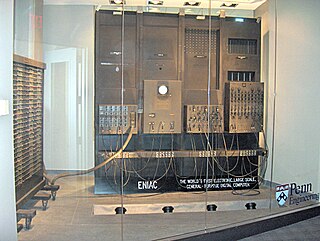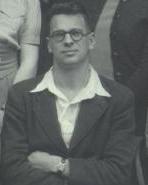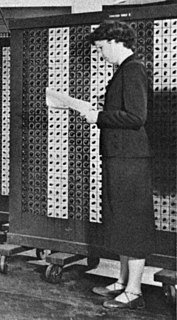Related Research Articles
Computer programming is the process of performing a particular computation, usually by designing and building an executable computer program. Programming involves tasks such as analysis, generating algorithms, profiling algorithms' accuracy and resource consumption, and the implementation of algorithms. The source code of a program is written in one or more languages that are intelligible to programmers, rather than machine code, which is directly executed by the central processing unit. The purpose of programming is to find a sequence of instructions that will automate the performance of a task on a computer, often for solving a given problem. Proficient programming thus usually requires expertise in several different subjects, including knowledge of the application domain, specialized algorithms, and formal logic.

COBOL is a compiled English-like computer programming language designed for business use. It is an imperative, procedural and, since 2002, object-oriented language. COBOL is primarily used in business, finance, and administrative systems for companies and governments. COBOL is still widely used in applications deployed on mainframe computers, such as large-scale batch and transaction processing jobs. However, due to its declining popularity and the retirement of experienced COBOL programmers, programs are being migrated to new platforms, rewritten in modern languages or replaced with software packages. Most programming in COBOL is now purely to maintain existing applications; however, many large financial institutions were still developing new systems in COBOL as late as 2006.

Grace Brewster Murray Hopper was an American computer scientist and United States Navy rear admiral. One of the first programmers of the Harvard Mark I computer, she was a pioneer of computer programming who invented one of the first linkers. Hopper was the first to devise the theory of machine-independent programming languages, and the FLOW-MATIC programming language she created using this theory was later extended to create COBOL, an early high-level programming language still in use today.

The Semi-Automatic Ground Environment (SAGE) was a system of large computers and associated networking equipment that coordinated data from many radar sites and processed it to produce a single unified image of the airspace over a wide area. SAGE directed and controlled the NORAD response to a possible Soviet air attack, operating in this role from the late 1950s into the 1980s. Its enormous computers and huge displays remain a part of cold war lore, and after decommisioning were common props in movies such as Dr. Strangelove and Colossus, and on science fiction TV series such as The Time Tunnel.

ENIAC was the first programmable, electronic, general-purpose digital computer, completed in 1945. There were other computers that had these features, but the ENIAC had all of them in one package. It was Turing-complete and able to solve "a large class of numerical problems" through reprogramming.

Whirlwind I was a Cold War-era vacuum tube computer developed by the MIT Servomechanisms Laboratory for the U.S. Navy. Operational in 1951, it was among the first digital electronic computers that operated in real-time for output, and the first that was not simply an electronic replacement of older mechanical systems.

Fernando José "Corby" Corbató was a prominent American computer scientist, notable as a pioneer in the development of time-sharing operating systems.

David John Wheeler FRS was a computer scientist and professor of computer science at the University of Cambridge.
Calvin Northrup Mooers, was an American computer scientist known for his work in information retrieval and for the programming language TRAC.

Tom Kilburn was an English mathematician and computer scientist. Over the course of a productive 30-year career, he was involved in the development of five computers of great historical significance. With Freddie Williams he worked on the Williams–Kilburn tube and the world's first electronic stored-program computer, the Manchester Baby, while working at the University of Manchester. His work propelled Manchester and Britain into the forefront of the emerging field of computer science.

Roger D. Moore was the 1973 recipient of the Grace Murray Hopper Award from the Association for Computing Machinery (ACM). It was given "for their work in the design and implementation of APL\360, setting new standards in simplicity, efficiency, reliability and response time for interactive systems."

The Office of Naval Research (ONR) is an organization within the United States Department of the Navy responsible for the science and technology programs of the U.S. Navy and Marine Corps. Established by Congress in 1946, its mission is to plan, foster, and encourage scientific research to maintain future naval power and preserve national security. It carries this out through funding and collaboration with schools, universities, government laboratories, nonprofit organizations, and for-profit organizations, and overseeing the Naval Research Laboratory, the corporate research laboratory for the Navy and Marine Corps. NRL conducts a broad program of scientific research, technology and advanced development.
Edmund Callis Berkeley was an American computer scientist who co-founded the Association for Computing Machinery (ACM) in 1947. His 1949 book Giant Brains, or Machines That Think popularized cognitive images of early computers. He was also a social activist who worked to achieve conditions that might minimize the threat of nuclear war.
Jean E. Sammet was an American computer scientist who developed the FORMAC programming language in 1962. She was also one of the developers of the influential COBOL programming language.

Frances Elizabeth Holberton was an American computer scientist who was one of the six original programmers of the first general-purpose electronic digital computer, ENIAC. The other five ENIAC programmers were Jean Bartik, Ruth Teitelbaum, Kathleen Antonelli, Marlyn Meltzer, and Frances Spence.
Daniel L. Murphy is an American computer scientist notable for his involvement in the development of TECO, the operating systems TENEX and TOPS-20, and email.
Roger Lee Sisson was an early data processing pioneer. Sisson worked on Project Whirlwind while a graduate student at MIT, co-founded the first consulting firm devoted to electronic data processing, and published a number of the earliest books and periodicals on computers and data processing.
The Digital Computer Association (DCA) was established in November 1952 in Santa Monica, California. It was disbanded in 1994.

Perry Orson Crawford, Jr. was an American computer pioneer credited as being the first to fully realize and promote the value of digital, as opposed to analog, computers for real-time applications. This was in 1945 while advising Jay Forrester in developing flight simulators and anti-aircraft fire control devices during World War II, before practical digital computers had been produced. His similar foresight on related issues led to his heading twelve years later the design team for IBM's SABRE project, the ticketing system for American Airlines, the first large-scale commercial application of real-time computer systems, which became the model for on-line transaction processing.

Programming Languages: History and Fundamentals is a book about programming languages written by Jean E. Sammet. Published in 1969, the book gives an overview of the state of the art of programming in the late 1960s, and records the history of programming languages up to that time.
References
- 1 2 Office of Naval Research (4 June 2014). "Lot 174, Digital Computer Newsletter". Bonham's. Retrieved 28 December 2014.
- ↑ "Index of /pdf/onr/Digital_Computer_Newsletter". www.bitsavers.org. You can find missing volumes on Defense Technical Information Center, search for phrase with quotes "Digital Computer Newsletter volume x", where x is a number from 1 to 20. Retrieved 2018-05-01.
{{cite web}}: CS1 maint: others (link) - ↑ Smith, Albert; Smith, Charles V. L. (February 1949). "Digital Computers and their Applications". Journal of the American Society for Naval Engineers. 61 (1): 137. doi:10.1111/j.1559-3584.1949.tb05325.x.
- ↑ Redmond; Smith (1980). Whirlwind: a pioneer computer. Maynard, MA: Digital Press. p. 154.
- 1 2 Williams, Kathleen Broome (2001). Improbable Warriors: Women scientists and the U.S. Navy in World War II. Annapolis, MD: Naval Institute Press.
- ↑ Wagner, Frank, ed. (July 1983). "Comments, Queries, and Debates". Annals of the History of Computing. 5 (3): 305. doi:10.1109/MAHC.1983.10087.
- ↑ Sammet, Jean E (October 1985). "Brief summary of the early history of COBOL". Annals of the History of Computing. 7 (4): 289. doi:10.1109/MAHC.1985.10044. S2CID 23933737.